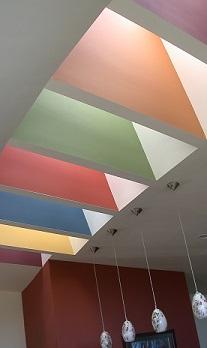Scope
In living spaces, utilize third-party certified low-emission paints and finishes that are designed to reduce human exposure indoors to individual VOCs. At least 90 percent of the interior surface area covered by site-applied paints and coatings shall use low-VOC or no-VOC products certified by one of the following third-party standards or certifications:
- GREENGUARD or GREENGUARD GOLD Certification for Paints and Coatings, OR
- Scientific Certification Systems (SCS) Standard EC-10.3-2014, Indoor Advantage Gold, OR
- A third-party low-emitting product list based on CA Section 01350 (CDPH Standard Method V1.2-2017), OR
- Green Seal Standard GS-11, OR
- Green Wise and Green Wise Gold products, OR
- Master Painters Institute (MPI) Green Performance Standards X-Green, GPS-1 or GPS-2.

The How to Find Indoor airPLUS Compliant Low Emission Products document provides guidance on identifying compliant products including industry databases and examples of product labeling. The guide also includes more detailed descriptions of the compliant third-party standards and certifications applicable to interior paints and finishes. Utilize this guide when outlining detailed product certifications to be included in the project specifications and/or subcontractor bid package.
See the Compliance tab for links to related codes and standards and voluntary federal energy-efficiency program requirements.
Description
Interior paints and finishes may contain Volatile Organic Compounds (VOCs). VOCs include a variety of chemicals, some of which may have short- and long-term adverse health effects. Concentrations of many VOCs are consistently higher indoors (up to ten times higher) than outdoors. VOCs are emitted by a wide array of products. Examples include: paints and lacquers, paint strippers, cleaning supplies, pesticides, building materials and furnishings, office equipment such as copiers and printers, correction fluids and carbonless copy paper, graphics and craft materials including glues and adhesives, permanent markers, and photographic solutions.
VOCs can cause eye, nose, and throat irritation; headaches; loss of coordination and nausea; and damage to the liver, kidneys, and central nervous system. Some organics can cause cancer in animals; some are suspected or known to cause cancer in humans. Key signs or symptoms associated with exposure to VOCs include conjunctival irritation, nose and throat discomfort, headache, allergic skin reaction, dyspnea, declines in serum cholinesterase levels, nausea, emesis, epistaxis, fatigue, and dizziness.

When found in building materials, VOCs tend to be emitted at higher levels when materials are new, with emissions lessening over time. This can mean that VOC emissions in a home could be particularly high during construction and upon first occupancy. To protect indoor air quality for both occupants and contractor staff, the best approach is to limit use of VOC-containing materials by specifying and purchasing low- or no-VOC products. Paints, sealants, coatings and adhesives are building products that traditionally contain VOCs. However, there is an increasing supply of low-and no-VOC alternatives, and often manufacturers will supply both an original formula as well as a low-VOC formula. Although some contractors may express concern as to the adhesive quality of low- or no-VOC products, this concern is not necessarily well-founded, and working with the product supplier can help to ensure an equivalent low-emission product is selected.
Using certified products lowers occupants’ risk of exposure to high levels of VOCs from construction materials. These Indoor airPLUS specifications can be implemented by requiring documentation of material certification for each material submittal package from sub-contractors. Any submittal requirements, such as manufacturer documentation of product certifications, should be clearly outlined in the project specifications and/or subcontractor bid package. Information for each third party certification and emissions standard required by Indoor airPLUS can be found in the How to Find Indoor airPLUS Compliant Low-Emission Products document.
Success
To meet Indoor airPLUS specifications, include product certification requirements for interior paints and finishes in the project specifications and/or bid package. In general, the most progressive low-emission paint certifications are based on California 01350, the Standard Method for the Testing and Evaluation of Volatile Organic Chemical Emissions from Indoor Sources using Environmental Chamber. This standard, updated in February 2010, established emissions requirements to ensure the certifications follow a standard practice for product testing and VOC calculations. However, not all third party certifications compliant with Indoor airPLUS are based on California 01350. While these certifications do not all have the exact same level of stringency or testing protocols, they currently provide a variety of reliable and market-available low-emission paints and finishes.
Even when selecting certified paints, coatings, cabinets, carpet and composite wood, these products may not be 100% emissions-free. Therefore, to protect construction teams and future occupants, ventilate the home during and shortly after installing products that are known sources of contaminants (e.g., cabinets, carpet padding, paint, and other finishes) and during the time between construction completion and occupancy. See Indoor airPLUS Item 7.2 for more details on ventilation strategy to dilute pollutants.
Climate
No climate specific information applies.
Training
Compliance
Compliance
Retrofit
SCOPE
Guidance for the measures described in this guide is applicable to both new and existing homes.
Follow safe work practices as described in the Global Worker Safety section of the Standard Work Specifications.
More
More Info.
Access to some references may require purchase from the publisher. While we continually update our database, links may have changed since posting. Please contact our webmaster if you find broken links.
The following authors and organizations contributed to the content in this Guide.
U.S. Environmental Protection Agency, Indoor airPlus program and PNNL.
Sales
Low/No VOC Paints and Finishes = Certified Low/No VOC Finishes

Interior paints and finishes may contain volatile organic compounds (VOCs) as a plasticizer. VOCs include a variety of chemicals, some of which may have short- and long-term adverse health effects, including eye, nose, and throat irritation; headaches; loss of coordination and nausea; allergic skin reactions; and damage to the liver, kidneys, and central nervous system. Certified low/no-VOC finishes help protect indoor air quality for both occupants and construction workers. Best practices also include airing out the house thoroughly during construction and in the first few weeks after paints and sealants have been applied when any VOC concentrations would be at their highest.

